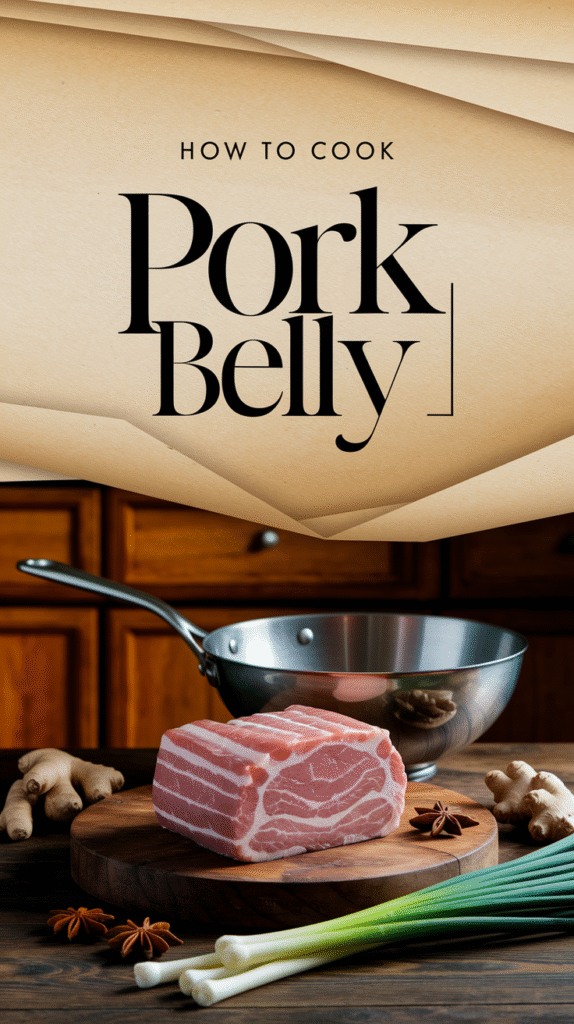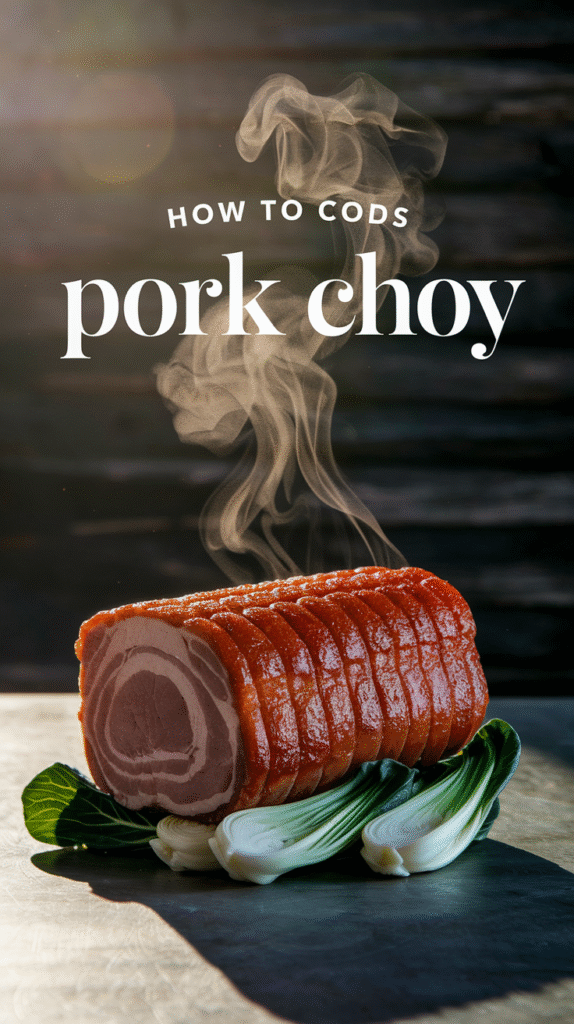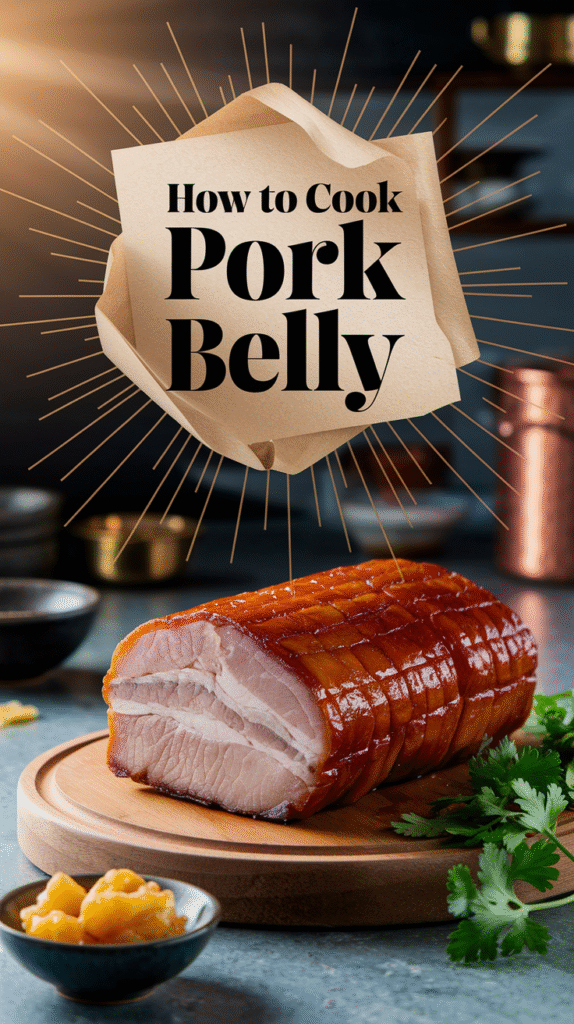Pork belly is a delicious and versatile cut of meat that can elevate your culinary game to a whole new level. Being rich in flavor, the trick to mastering the art of cooking pork belly lies in perfecting the techniques and understanding how to best complement its unique qualities.
First, let’s explore the basics of selecting the right pork belly. Look for a piece that has a good balance of meat and fat. The fat should be creamy-white, and the meat should be pinkish-red. An ideal pork belly will have a nice layer of skin on top. This layer will become crispy and delightful once cooked correctly. If you’re looking for quality meat, check out Local Harvest for nearby farms that provide pasture-raised pork.
Now, let’s break down the steps for cooking pork belly perfectly.
Preparing the Pork Belly
1. **Score the Skin:** Use a sharp knife to make shallow cuts into the skin in a crisscross pattern. Be careful not to cut too deep. Scoring allows the fat to render out during cooking, leading to that perfect crispy layer.
2. **Brine or Dry Rub:** Consider brining your pork belly in a mixture of water, salt, and spices for a few hours. This helps to enhance flavor and moisture. Alternatively, you can dry rub it with your favorite spices, ensuring to cover every inch, including the cuts you made in the skin.
Cooking Techniques
There are various methods to cook pork belly, but a few are particularly favored for their results:
- Slow Roasting: This method allows the fat to render slowly, resulting in juicy meat and crispy skin. Preheat your oven to 400°F (200°C) after seasoning your pork belly. Place it in a roasting pan, skin side up, and cook for about two hours. Then, increase the temperature to 450°F (230°C) for the last 30 minutes to achieve crispy skin.
- Braising: For a fall-apart tender texture, braise your pork belly. Start by searing the meat in a heavy pot, then add broth or sauce, cover, and simmer on low for 2-3 hours until tender.
- Grilling: Grilling gives a smoky flavor. Cut the pork belly into slices and grill over medium-high heat for about 5-7 minutes per side. Ensure to keep an eye on it, as the fat can catch fire.
Internal Temperature
To guarantee perfect doneness, aim for an internal temperature of 190°F (88°C) for the most tender result. You can use a meat thermometer to check this accurately. If you want the skin crispy, you may have to let it reach around 200°F (93°C) for that beautiful texture without drying it out.
Serving Suggestions
Pork belly can be served in various ways:
- As a Main Course: Pair it with sides like roasted vegetables, mashed potatoes, or a tangy coleslaw.
- In Tacos: Slice and serve in warm tortillas with fresh herbs and a drizzle of lime juice.
- As a Salad Topping: Crispy pork belly can elevate your salad with its rich flavor.
Don’t forget to let your cooked pork belly rest for about 10-15 minutes before slicing. This resting time allows the juices to redistribute within the meat, ensuring each bite is full of flavor. For more techniques on pork belly cooking, you can explore Serious Eats and get a deeper insight into flavor profiles and recipes.
Mastering the art of cooking pork belly takes a bit of practice, but with these techniques and tips, you’ll be serving up a delicious dish that impresses your family and friends. Whether you prefer it slow-roasted, braised, or grilled, the right approach will elevate this humble cut into a gourmet experience.
Flavor Profiles to Elevate Your Pork Belly Dish
Pork belly is a versatile and flavorful cut of meat that can be transformed into a range of exciting dishes. To enhance your pork belly experience, consider the following flavor profiles that can elevate your dish and tantalize your taste buds.
Sweet and Spicy
The combination of sweetness and heat creates a balanced flavor profile that works beautifully with pork belly. Here are some ingredients to try:
- Honey or Maple Syrup: These natural sweeteners caramelize beautifully and add a rich flavor.
- Sriracha or Chili Paste: Provides a kick of heat that contrasts nicely with the sweetness.
- Brown Sugar: A great addition for a sugary glaze; it can create a crispy, delightful exterior.
One example is a honey sriracha pork belly glaze that combines the flavors to create a sticky and delicious dish.
Herbs and Citrus
Adding fresh herbs and citrus can brighten up your pork belly dish, bringing a fresh, vibrant flavor to the rich meat. Consider using:
- Fresh Thyme and Rosemary: These herbs impart an earthy flavor that complements pork very well.
- Orange or Lemon Zest: The zest adds brightness, while the juice can tenderize the meat.
- Garlic and Ginger: These aromatics enhance the overall profile and infuse the dish with layers of flavor.
Try making a herb-infused citrus marinade for your pork belly, letting it rest overnight for maximum flavor absorption.
Umami Boost
Umami is known as the fifth taste, and incorporating umami flavors can deepen the richness of your pork belly. Here are some ideas:
- Soy Sauce: Use as a marinade to infuse savory goodness.
- Miso Paste: A traditional Japanese ingredient that adds depth and complexity.
- Smoked Paprika: Enhances smokiness without needing a grill.
Consider a miso-glazed pork belly for a dish that truly exemplifies umami flavors.
Sweet and Tangy BBQ
A classic combination with pork, sweet and tangy BBQ flavors can make your pork belly irresistible. To create this profile, combine:
- Barbecue Sauce: Look for a balanced sauce that offers both sweetness and tang.
- Apple Cider Vinegar: A splash can add acidity and helps to tenderize the meat.
- Mustard: Adds a zing that cuts through the richness of the belly.
Try slow-cooking your pork belly in a BBQ sauce for an exceptional meal that melds all these flavors together.
Asian Inspirations
Asian cuisines offer a plethora of flavors that pair beautifully with pork belly. Consider these ingredients:
- Five-Spice Powder: This blend of spices (star anise, cloves, Chinese cinnamon, Sichuan pepper, and fennel) delivers a warm and aromatic flavor.
- Hoisin Sauce: Sweet and salty, it adds depth and richness.
- Sesame Oil: A little goes a long way in adding nuttiness and gloss to your dish.
For a successful dish, marinate your pork belly in five-spice powder and hoisin sauce, then roast until tender and crispy.
Experimenting with these flavor profiles can lead to delicious and memorable pork belly dishes that impress your friends and family. Don’t be afraid to mix and match flavors to discover your unique combination!
For more inspiration and recipes, check out Serious Eats and Food Network.
Common Mistakes When Cooking Pork Belly and How to Avoid Them
Cooking pork belly can be a rewarding experience, but it’s also easy to make a few common mistakes that can affect the final dish. Whether you’re a novice cook or have some experience in the kitchen, avoiding these pitfalls will help you achieve that perfectly crispy crackling and tender meat that everyone loves.
Choosing the Wrong Cut
One common mistake is selecting the wrong cut of pork belly. Not all pork belly is created equal. You want to choose a cut that has a good balance of meat and fat for the best flavor and texture. Look for a piece with uniform thickness and a nice layer of fat on top. The skin should be intact and appear fresh without blemishes.
Improper Seasoning
Another frequent error is not seasoning the pork belly adequately. Seasoning is crucial for enhancing the natural flavors of the meat. Follow these steps to ensure your pork belly is well-seasoned:
- Pat the pork belly dry with paper towels to remove excess moisture.
- Rub a generous amount of salt all over the skin and meat.
- Consider adding spices like pepper, garlic powder, or even a dash of cayenne for extra flavor.
Not Scoring The Skin
Failing to score the skin can lead to a disappointing crackling. Scoring involves making shallow cuts in the skin, which allows fat to render out and facilitates crisping. Here’s how to score pork belly:
- Use a sharp knife to make diagonal cuts across the skin, being careful not to cut into the meat.
- Space the cuts about an inch apart to allow for adequate crisping.
Insufficient Cooking Time
Cooking pork belly requires patience. Rushing the cooking process often leads to tough meat and chewy skin. It’s better to cook the pork belly slowly at a low temperature to break down the connective tissue. Try cooking at 300°F (about 150°C) for several hours until tender. Finish with a quick high-heat blast to crisp the skin. A temperature chart may be helpful:
| Cooking Method | Temperature | Cooking Time |
|---|---|---|
| Slow Roast | 300°F (150°C) | 3-4 hours |
| Finish for Crisp | 450°F (232°C) | 20-30 minutes |
Skipping Rest Time
Letting the pork belly rest after cooking is a step many cooks overlook. Resting allows the juices to redistribute throughout the meat, ensuring each bite is flavorful and moist. Let it rest for at least 15-20 minutes before slicing. This simple step can greatly enhance the overall dining experience.
Overcooking or Undercooking
Getting the cooking time right is crucial. Overcooked pork belly can become dry, while undercooked pork belly could be tough. Use a meat thermometer to check the internal temperature should reach at least 190°F (about 88°C) for the best results. If you’re unsure, it’s always better to rely on a thermometer than to guess.
Forgetting About Accompaniments
Pork belly pairs wonderfully with a variety of side dishes that enhance its richness. Don’t forget to serve it with contrasting flavors like:
- Pickled vegetables
- Creamy coleslaw
- Spicy sauces
- Sweet or tangy fruits like apple or mango salsa
Choosing the Wrong Cooking Technique
The method you choose to cook pork belly can greatly affect the outcome. Techniques such as braising, roasting, or even sous-vide can yield excellent results. Whichever method you choose, be sure to follow the specific steps required to unlock the flavors and tenderness you desire.
With these tips, you’re well on your way to mastering pork belly. For additional details and recipes, you can visit Serious Eats or BBC Good Food. Each resource offers valuable insights that can help refine your cooking techniques and inspire your culinary journey.
Pork Belly Recipes from Around the World
Pork belly has gained popularity worldwide for its rich flavor and tender texture. This versatile cut of meat can be transformed into a variety of dishes, each reflecting the culinary traditions of its region. Let’s explore some distinct pork belly recipes from around the globe.
Asian Pork Belly Dishes
In Asia, pork belly is often featured in comfort food. Here are a few popular dishes:
- Korean Samgyeopsal: This Korean BBQ dish involves grilling thick slices of pork belly at the table. Diners wrap the cooked meat in lettuce leaves and add garlic, chili peppers, and dipping sauces, making it a fun and interactive meal.
- Chinese Dong Po Rou: This braised pork belly dish is a celebrated centerpiece in Chinese cuisine. The pork is slow-cooked in a mix of soy sauce, rice wine, and spices until it’s melt-in-your-mouth tender. It’s often served with steamed buns or rice.
- Vietnamese Thit Kho: This traditional dish features pork belly simmered in coconut juice and fish sauce, resulting in a sweet and savory flavor. Usually served with rice, it offers a comforting taste of home for many Vietnamese families.
European Pork Belly Delicacies
Europe boasts several unique ways to prepare pork belly, highlighting its rich culinary history:
- Italian Porchetta: A festive centerpiece, porchetta is a whole pig, deboned and stuffed with herbs like rosemary and garlic. The pork belly, with its crispy skin, is the star, offering an explosion of flavors when sliced.
- German Schweinshaxe: This roasted pork knuckle, often served with a crispy skin and tender meat, features pork belly’s delicious attributes. It’s typically seasoned with salt and spices before roasting, served alongside sauerkraut and potato dumplings.
- Spanish Panceta: In Spain, pork belly is often cured, resulting in panceta. It can be enjoyed sliced thin with bread or cooked as part of traditional stews, providing deep flavor to the dish.
South American Pork Belly Concepts
South America has distinguished itself with several pork belly recipes that showcase robust flavors:
- Brazilian Farofa: This dish features crispy pork belly served with farofa, toasted cassava flour. The belly is cooked until crunchy and is a popular addition to many meals, providing a satisfying crunch and flavor.
- Peruvian Seco de Cerdo: This rich pork belly stew combines cilantro, beer, and various spices. The slow-cooked meat absorbs the flavors, creating a hearty dish often accompanied by rice and beans.
Pork Belly Cooking Techniques
Regardless of the culinary tradition, there are several methods to cook pork belly that can elevate your dish:
| Cooking Method | Key Points |
|---|---|
| Roasting | Creates a crispy exterior while keeping the inside tender. Season liberally and cook slowly to achieve the best results. |
| Braising | Braises the pork belly in flavorful liquids for several hours, ensuring the meat is full of flavor and soft. |
| Grilling | Quick method that gives a nice char. Ideal for thicker slices of pork belly. |
With these diverse recipes, you can experience pork belly in a variety of styles, each telling a unique story from its cultural roots. From Asian barbecues to European family feasts, this cut of meat brings people together around the dinner table.
For more detailed recipes and cooking tips, visit Serious Eats and Bon Appétit. Discover how to master the art of cooking pork belly and elevate your culinary skills!
Pairing Side Dishes and Sauces with Pork Belly
Pork belly is a delicious and versatile cut of meat that can elevate your culinary creations. While the rich flavor of pork belly stands out on its own, pairing it with the right side dishes and sauces can enhance the dining experience. Here are some excellent options for side dishes and sauces to serve alongside your perfectly cooked pork belly.
Classic Side Dishes
When it comes to pairing classic side dishes with pork belly, consider the following options:
- Coleslaw: A tangy and crunchy coleslaw complements pork belly’s richness. The acidity from the vinegar and the freshness of the vegetables create a perfect balance.
- Mashed Potatoes: Creamy mashed potatoes provide a smooth and comforting side. You can add garlic or cheese to enhance the flavor even more.
- Rice: Steamed white rice or buttery rice pilaf works well for soaking up the juices from the pork belly. You can also try flavored rice, like jasmine or basmati.
- Grilled Vegetables: Seasoned and grilled veggies add a smoky flavor. Try bell peppers, zucchini, and asparagus for a colorful plate.
Vegetable-Based Options
For those seeking healthier alternatives or vegetarian pairings, here are some great vegetable-based options:
- Roasted Brussels Sprouts: Roasting Brussels sprouts until they’re crispy adds a delicious crunch to your meal. Toss them with balsamic vinegar for added flavor.
- Sauteed Greens: Greens like kale or spinach, when sautéed with some garlic and olive oil, will add a vibrant element to your dish.
- Pickled Vegetables: The crispness and acidity of pickled veggies can cut through the richness of pork belly wonderfully.
Delicious Sauces to Consider
The sauce you choose can dramatically change the flavor profile of your pork belly. Here are some sauces that pair beautifully:
- Soy Sauce Glaze: A sweet soy sauce glaze with honey or brown sugar can caramelize on the pork belly, creating a sticky and tasty finish.
- Hoisin Sauce: This savory and sweet sauce will add depth and complexity to your pork belly dish. Serve it as a dipping sauce on the side.
- Chimichurri: This herb-based sauce brings brightness and fresh flavors that complement the richness of pork belly.
- Mustard Sauce: A creamy mustard sauce adds a tangy zesty flavor that pairs wonderfully with pork belly.
Regional Pairings and Inspirations
Different cuisines offer unique pairings that can enhance your pork belly experience. Here are some regional inspirations:
| Region | Side Dish | Sauce |
|---|---|---|
| Asian | Steamed Bok Choy | Spicy Hoisin Sauce |
| Mexican | Pico de Gallo | Chipotle Sauce |
| Italian | Polenta | Tomato Basil Sauce |
| Southern | Cornbread | Pecan Maple Sauce |
Embracing different cultures can lead to exciting table experiences that both you and your guests will love.
Final Touches and Everything in Between
Don’t forget about the importance of garnishes. Fresh herbs like parsley or cilantro can brighten up the plate, providing visual appeal and freshness. Consider adding a squeeze of citrus, like lime or lemon, for an extra pop of flavor. ensure that all elements on the plate harmonize in flavors and colors for a well-balanced meal.
With so many delicious options for side dishes and sauces, you can create a stunning meal that highlights the incredible taste of pork belly. For further inspiration and recipes, visit Serious Eats and Food Network. Enjoy your culinary adventure with pork belly and all its perfect pairings!
Conclusion
Cooking pork belly can be both a delightful and rewarding experience when approached with the right techniques and knowledge. By mastering essential cooking methods, such as slow roasting, braising, or even grilling, you can achieve that perfect balance of crispy skin and tender, flavorful meat. Don’t shy away from experimenting with various flavor profiles, as each ingredient can dramatically elevate your dish, making your pork belly a standout at any table.
Be mindful of the common pitfalls to avoid when preparing pork belly. Ensuring that you render the fat properly and not overspicing are crucial for achieving the ideal texture and taste. By staying informed and avoiding these mistakes, you set yourself up for success in each cooking endeavor.
Exploring pork belly recipes from around the world allows you to enjoy its versatility and unlock exciting new flavors. Whether you opt for a spicy Asian glaze or a sweet and tangy barbecue rub, the global culinary landscape offers endless possibilities.
Complementing your pork belly with the right side dishes and sauces can enhance the entire meal. Think about fresh greens, creamy potatoes, or vibrant slaws to contrast the richness of the pork. Your choice of sauce, be it a zesty chimichurri or comforting apple sauce, can add brightness and depth to every bite.
With these insights and strategies, you are well-equipped to create delightful pork belly dishes that take center stage at any meal. Let your creativity shine, and soon you’ll discover that cooking pork belly isn’t just about food; it’s a culinary journey to be savored.







Leave a Reply